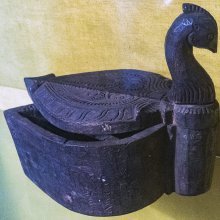Tatta, Tāttā: 8 definitions
Introduction:
Tatta means something in Hinduism, Sanskrit, Buddhism, Pali, Marathi, Jainism, Prakrit, biology, Tamil. If you want to know the exact meaning, history, etymology or English translation of this term then check out the descriptions on this page. Add your comment or reference to a book if you want to contribute to this summary article.
Images (photo gallery)
Biology (plants and animals)
Source: Google Books: CRC World Dictionary (Regional names)Tatta in India is the name of a plant defined with Abutilon indicum in various botanical sources. This page contains potential references in Ayurveda, modern medicine, and other folk traditions or local practices It has the synonym Sida populifolia Lam. (among others).
Example references for further research on medicinal uses or toxicity (see latin names for full list):
· Taxon (1982)
· Prodr. Flora Indica, or ‘Descriptions of Indian Plants’ Orient. (1834)
· Journal of Cytology and Genetics (1993)
· Journal of Palynology (1980)
· Encycl. (Lamarck) (1783)
· Recent Res. Pl. Sci. (1979)
If you are looking for specific details regarding Tatta, for example side effects, extract dosage, health benefits, diet and recipes, pregnancy safety, chemical composition, have a look at these references.

This sections includes definitions from the five kingdoms of living things: Animals, Plants, Fungi, Protists and Monera. It will include both the official binomial nomenclature (scientific names usually in Latin) as well as regional spellings and variants.
Languages of India and abroad
Pali-English dictionary
Source: BuddhaSasana: Concise Pali-English Dictionarytatta : (nt.) the real nature; reality. (pp. of tapati), heat; hot; glowing.
Source: Sutta: The Pali Text Society's Pali-English Dictionary1) Tatta, 2 (nt.) (tad+tva) truth; Abl. tattato according to truth; accurately J. II, 125 (ñatvā); III, 276 (ajānitvā not knowing exactly). (Page 295)
2) Tatta, 1 (pp. of tapati) heated, hot, glowing; of metals: in a melted state (cp. uttatta) A. II, 122≈(tattena talena osiñcante, as punishment); Dh. 308 (ayoguḷa); J. II, 352 (id.); IV, 306 (tattatapo “of red-hot heat, ” i.e. in severe self-torture); Miln. 26, 45 (adv. red-hot); PvA. 221 (tatta-lohasecanaṃ the pouring over of glowing copper, one of the punishments in Niraya). (Page 295)

Pali is the language of the Tipiṭaka, which is the sacred canon of Theravāda Buddhism and contains much of the Buddha’s speech. Closeley related to Sanskrit, both languages are used interchangeably between religions.
Marathi-English dictionary
Source: DDSA: The Molesworth Marathi and English Dictionarytaṭṭa (तट्ट).—ad (Imit.) Tightly, tensely, so distended and strained as to be ready to burst with a taṭṭa! v phuga, tāṇa, bhara.
--- OR ---
tattā (तत्ता).—a (About Solapur.) Light, low, mean, disreputable--a person.
Source: DDSA: The Aryabhusan school dictionary, Marathi-Englishtaṭṭa (तट्ट).—ad Tightly, tensely.
Marathi is an Indo-European language having over 70 million native speakers people in (predominantly) Maharashtra India. Marathi, like many other Indo-Aryan languages, evolved from early forms of Prakrit, which itself is a subset of Sanskrit, one of the most ancient languages of the world.
Sanskrit dictionary
Source: Cologne Digital Sanskrit Dictionaries: Edgerton Buddhist Hybrid Sanskrit DictionaryTaṭṭa (तट्ट) or Taṭṭu or Taṭṭuka.—(m. or nt.; = Pali taṭṭaka, a flattish bowl; otherwise unrecorded), some kind of bowl [Page247-2b+ 29] or dish: taṭṭukaṃ (acc.) Śikṣāsamuccaya 58.1; taṭṭa-kāra, bowl-maker, Mahāvastu ii.468.14, 18; iii.442.17 (here mss. tadva°, Senart wrongly em. taddhu°); taṭṭu-kāraka, id., Mahāvastu iii.113.13 (so read for taddhu°); taṭṭv-ākāra, bowl-shaped, to be read in Divyāvadāna 342.26; 343.5, for text tapv-āk°; this passage cited Śikṣāsamuccaya 58.1 taṭṭākāra (taṭṭa-āk°), but 58.5 taṭṭukākāra (taṭṭuka-āk°); miswritten khaṭvākāra, see khaṭu (2).
Sanskrit, also spelled संस्कृतम् (saṃskṛtam), is an ancient language of India commonly seen as the grandmother of the Indo-European language family (even English!). Closely allied with Prakrit and Pali, Sanskrit is more exhaustive in both grammar and terms and has the most extensive collection of literature in the world, greatly surpassing its sister-languages Greek and Latin.
Prakrit-English dictionary
Source: DDSA: Paia-sadda-mahannavo; a comprehensive Prakrit Hindi dictionary1) Tatta (तत्त) in the Prakrit language is related to the Sanskrit word: Tattva.
2) Tatta (तत्त) also relates to the Sanskrit word: Tapta.
3) Tatta (तत्त) also relates to the Sanskrit word: Tapta.
4) Tatta (तत्त) also relates to the Sanskrit word: Tatra.
Prakrit is an ancient language closely associated with both Pali and Sanskrit. Jain literature is often composed in this language or sub-dialects, such as the Agamas and their commentaries which are written in Ardhamagadhi and Maharashtri Prakrit. The earliest extant texts can be dated to as early as the 4th century BCE although core portions might be older.
Kannada-English dictionary
Source: Alar: Kannada-English corpusTaṭṭa (ತಟ್ಟ):—[noun] a Jaina or Buddha mendicant wearing traditional rough, unsewn cloth.
--- OR ---
Taṭṭa (ತಟ್ಟ):—[noun] = ತಟ್ಟು [tattu]5.
--- OR ---
Tatta (ತತ್ತ):—[noun] that which is or has been; a thing that has actually happened or is really true.
--- OR ---
Tatta (ತತ್ತ):—[noun] past. & pp of the verb ತಳ್ [tal]2.
--- OR ---
Tatta (ತತ್ತ):—[noun] past. & pp of the verb ತಳ್ [tal]3.
Kannada is a Dravidian language (as opposed to the Indo-European language family) mainly spoken in the southwestern region of India.
See also (Relevant definitions)
Starts with (+110): Tatola, Tatta-Kana-Kara, Tatta-payaru, Tatta-pittaenal, Tattaddeshiya, Tattadi, Tattadu, Tattai, Tattai-nakkupucci, Tattai-p-punku, Tattaiccampanki, Tattaikkarai, Tattaikkarunkollu, Tattaippayarrinkoti, Tattaippayaru, Tattaippucci, Tattaippunku, Tattaisu, Tattaiyammai, Tattaiyan.
Ends with (+78): Abhilakkhitatta, Abhiratatta, Abhitatta, Adhippetatta, Adhivimuttatta, Ahitatta, Akatatta, Akiritatta, Anotatta, Anubbillavitatta, Anunnatatta, Anupatitatta, Apetatta, Arihatatta, Atatta, Attatta, Avajjitatta, Bahitatta, Bhantatta, Bhavitatta.
Full-text (+8): Kittattatta, Cheppu tatta, Verrilaittattam, Tatta-payaru, Puntattam, Tapu, Tattakkirumi, Tatta-Kana-Kara, Konkantattam, Tatta-pittaenal, Tattu, Tatra, Tattva, Tapta, Mamattatta, Tattuka, Piriya-tattamantiram, Chambhitatva, Tattaka, Tattavomam.
Relevant text
Search found 9 books and stories containing Tatta, Taṭṭa, Tattā, Tāttā; (plurals include: Tattas, Taṭṭas, Tattās, Tāttās). You can also click to the full overview containing English textual excerpts. Below are direct links for the most relevant articles:
The Religion and Philosophy of Tevaram (Thevaram) (by M. A. Dorai Rangaswamy)
Nayanar 5: Meiporul (Meypporul) < [Volume 4.1.1 - A comparative study of the Shaivite saints the Thiruthondathogai]
Lord Jhulelal: An Analytical Study (by Thakkar Harish Gopalji)
Part 25 - Concrete proof in Gazetteer < [Chapter 2 - Literature Review]
Part 3 - Miracles < [Chapter 4 - Analysis]
Middle Chola Temples (by S. R. Balasubrahmanyam)
4. Icons set up By Rajaraja I’s Officers and others < [Tanjavur/Thanjavur (Rajarajesvaram temple)]
Folk Tradition of Bengal (and Rabindranath Tagore) (by Joydeep Mukherjee)
The Markandeya Purana (Study) (by Chandamita Bhattacharya)
Duties (Āhnika) or Moral obligation < [Chapter 2]
Nirvikalpaka Pratyaksha (study) (by Sujit Roy)




